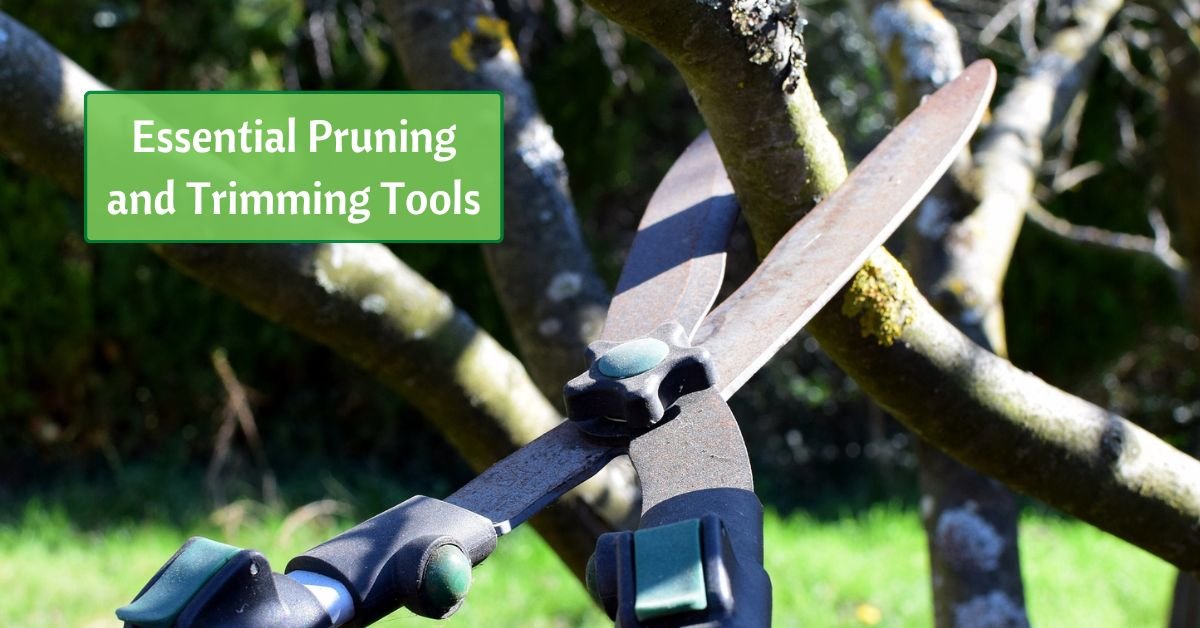Pruning and trimming are essential for maintaining the health and appearance of your garden, trees, and shrubs. To achieve the best results, you need to have the right tools at your disposal. Not sure if you have everything you need? Read on as we explore a variety of tools for pruning and trimming, discussing their features, best uses, and how to care for them.
Hand Pruners
Hand pruners are the most basic tool for doing up-close trimming. There are three basic types: bypass, anvil, and ratchet pruners.
Bypass Pruners
Bypass pruners, also known as hand pruners or secateurs, are the go-to tool for precise and clean cuts. They feature two curved blades that pass by each other, similar to scissors.
Bypass pruners are ideal for cutting live branches and stems up to an inch in diameter. They provide clean cuts which reduces the risk of damaging the plant.
Anvil Pruners
Anvil pruners have a single sharp blade that cuts against a flat surface or “anvil.” These pruners are suitable for cutting dead wood and thick branches.
However, they may crush live branches if not used carefully. So they may not be the best options for delicate pruning tasks.
Ratchet Pruners
Ratchet pruners have a unique mechanism that allows you to make cuts in stages. That’s perfect for handling thicker branches. They provide added leverage, reducing hand fatigue when dealing with challenging cuts.
Loppers
Loppers are two-handed tools designed for tougher jobs. Their longer handles can also make them useful for those times you have to reach a bit further.
Bypass Loppers
Bypass loppers are designed for cutting branches and stems ranging from 1 to 2 inches in diameter. They operate similarly to bypass pruners and make clean and precise cuts. These tools are ideal for pruning trees, shrubs, and larger plants.
Anvil Loppers
Anvil loppers, like anvil pruners, have a single blade that cuts against a flat surface. They are best suited for cutting dead or woody branches, providing the necessary leverage for larger cuts.
Gear-Driven Loppers
Gear-driven loppers incorporate a gear mechanism that multiplies cutting power, allowing you to cut through thicker branches with less effort. They are a great choice for tackling challenging pruning tasks, whether it’s a tougher cut or a large amount of cuts you need to make.
Hedge Shears
Hedge shears are designed for shaping and trimming hedges and shrubs. They have long, straight blades with serrated edges that create precise, even cuts.
Some models also have extendable handles for reaching high or hard-to-access areas.
Pruning Saws
Pruning saws come in various sizes and shapes, including folding and fixed-blade models. They are ideal for cutting larger branches and thick stems that hand pruners or loppers cannot handle. Pruning saws have sharp, aggressive teeth that make quick work of woody growth.
Pole Pruners
Pole pruners consist of a long pole with a pruning head at the end, usually operated by a rope or lever. They are designed for trimming high branches without the need for a ladder. Pole pruners are ideal for safely reaching and pruning branches in tall trees.
Make Work Easier with Electric or Cordless Pruners
Electric or cordless pruners are powered tools that make pruning and trimming tasks more manageable. They are especially useful for individuals with limited hand strength or mobility. These pruners come in various designs, including handheld models and pole-mounted versions.
Caring for Your Pruning and Trimming Tools
Proper maintenance of your pruning and trimming tools is essential to ensure their longevity and performance. Here are some tips for keeping your tools in top condition:
- Clean After Use: Remove sap, resin, and debris from your tools after each use. Use a wire brush or putty knife to remove stubborn residue.
- Sharpen Blades: Regularly sharpen the cutting edges of your tools with a sharpening stone or file. Sharp blades make cleaner cuts and reduce the effort required for pruning.
- Oil and Lubricate: Apply a light coating of oil or lubricant to the moving parts and joints of your tools to prevent rust and ensure smooth operation.
- Inspect for Damage: Check your tools for any signs of damage, such as bent blades or loose parts. Repair or replace damaged components as needed.
- Store Properly: Store your pruning and trimming tools in a dry, cool place to prevent rust. Hang them on a pegboard or use a tool rack to keep them organized and easily accessible.
The right tools for pruning and trimming make it easier to maintain the health and beauty of your garden and landscape. Whether you’re working on delicate flowers, shrubs, or mature trees – or even dead ones – there’s a tool designed to meet your needs.
Select the appropriate tool for each task and care for it properly to ensure that your pruning and trimming endeavors are efficient and successful. And that will help your outdoor space thrive year after year!









